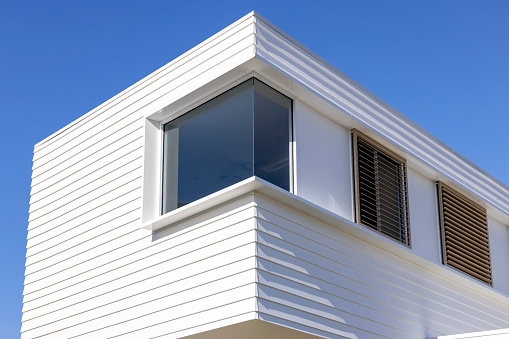Constructing a house and making enhancements to it are essential responsibilities for homeowners. While modifying the features and opting for a new appearance is exciting, it can also be time-consuming, especially choosing the right exterior cladding material, where there are many options. To ensure a safe living environment, selecting premium materials and hiring dependable builders is crucial.
Selecting the appropriate wall cladding is one of the most critical aspects of constructing a new house. This involves creating a protective layer around your walls to shield them against moisture and other harmful irritants. With various wall cladding options, it is crucial to conduct proper research and choose the most suitable alternative.
Factors to Consider When Choosing Your Home Cladding
Before diving into the different types of cladding materials, it is essential to consider some factors that will help you make the right decision. Here are some factors to consider when choosing a cladding:
Protection
External wall cladding serves as a vital shield to safeguard the walls of your home from the harsh impacts of weather conditions, such as heavy rain, storms, hail, snow, extreme cold, and extreme heat. The ideal cladding material should efficiently repel moisture, prevent the walls from expanding or contracting due to temperature changes, and deter pests from creating habitats within your home’s walls.
Budget
The cost of cladding is influenced by structural capacity and material availability. It is important to select an affordable cladding option without compromising the quality of the materials. Occasionally a more expensive product may offer long-term savings.
Durability and Quality
The structural integrity, longevity, and sturdiness of the cladding you opt for can greatly impact your building. The cladding’s durability must align with the expected lifespan of your structure.
Maintenance Cost
While many people focus on the initial cost of installation, it’s important to think long-term. Different types of cladding require different maintenance levels, from regular cleaning to occasional painting or staining. By choosing an option that requires less maintenance, you can save money and hassle in the long run. It’s also important to consider the climate and other factors that can impact maintenance needs.
Types of Exterior Cladding Materials
There are several different types of exterior cladding materials to choose from. Here are some of the most popular options:
Vinyl cladding
The cheapest cladding option available in a variety of colours is vinyl cladding. One advantage of selecting vinyl cladding is that it is low-maintenance, unlike other types of cladding, which require regular repainting and repairs or may deteriorate over time. Additionally, vinyl cladding is sustainable since it is 100% recyclable.
Adding an insulation layer can also help regulate the temperature in a building, keeping it warm at night and cool during the day.
Furthermore, vinyl cladding is lightweight, making it easy to adjust panels when covering a building. It is also durable, resisting dents, fading, and flaking.
Metal cladding
Aluminum and other metal cladding are also popular due to their modern and shiny appearance, especially for revamping old, worn-out buildings.
The pliability of metal makes it easy to work with and offers versatility. It requires little maintenance and does not absorb moisture, minimizing the risk of fungi and algae growth.
Additionally, it is lightweight and fire-resistant, although it may not provide the best sound insulation. Despite this, various materials can be added to enhance its soundproofing properties.
Metal cladding offers a range of colours and textures, and aluminum cladding, in particular, is highly energy-efficient
Glass Cladding
Glass cladding has become an increasingly popular choice for exterior building facades. This material is aesthetically pleasing and provides several functional benefits. Glass cladding is an energy-efficient material that can reduce heating and cooling costs. Additionally, it offers superior insulation and is highly resistant to moisture and weathering. Glass also allows natural light to enter the building, improving indoor lighting and reducing reliance on artificial lighting.
Fibre Cement Cladding
Fibre cement is a construction material made from a blend of cement and cellulose fibers, offering a durable and protective layer when used for exterior cladding. These boards or sheets interlock to provide a weather-resistant shield for residential and commercial buildings. With a lifespan of at least half a century, it can withstand extreme weather conditions and resist insect infestations.
Additionally, this cladding provides insulation due to its low thermal conductivity, which can lower electricity consumption. It also requires no upkeep and remains functional for many years after installation.
Brick Cladding
Brick slips or skins have become increasingly popular, although they have historically been utilized as a self-supporting, ground-bearing wall in recent years. These slips are attached to a base fixed to an internal wall, allowing for quick installation of external insulation in any home.
However, it is important to note that brick slips are one of the more expensive options for house cladding.
Additionally, they are not as environmentally friendly as several other cladding materials due to the significant energy needed to produce bricks and the larger carbon footprint of the brick and cement industry.
Stone Cladding
Stone siding is a luxurious option that adds a unique and rustic look to a home’s exterior. There are various options, including natural stone, cultured stone, and stone veneer.
Stone is a durable and long-lasting material that is resistant to weather and insect damage, making it a low-maintenance option.
However, stone is an expensive option and can be challenging to install. It is also heavy, adding additional costs to the building structure.
Wood/Timber Cladding
Among all cladding types, timber is widely considered the most visually appealing. It’s a popular choice for external cladding in both commercial and residential buildings, thanks to its natural warmth and comforting feel.
Timber comes in various colours, styles, and textures that can add a distinctive touch to any building, making it stand out. Despite its undeniable aesthetic quality, the installation and maintenance of timber cladding can be quite costly.
However, the unique and unmatched look of wooden cladding is worth the investment.
Maintaining Your Wall Cladding
Maintaining your wall cladding is essential, regardless of the type you have. For interior wall cladding, use appropriate cleaning products and avoid using water.
While some exterior wall cladding may require less maintenance, neglecting them can lead to unnoticed damages and cracks.
To ensure that your property is in good condition, hiring a professional for inspections is recommended.
Alternatively, if you prefer to do it yourself, focus on checking areas around doors and windows, as they are more prone to cracking. If you notice any dirt, stains, or broken cladding, it’s important to address them promptly.
Conclusion
Exterior cladding is a great way to update the look of your home while protecting it from the elements. However, you must choose the right material for your project if you want it to be successful. Considering energy efficiency, design, and affordability are all key.
At Phoenix Siding, we offer metal cladding and various exterior renovation services to meet all homeowner needs. We can help you pick out the perfect material and design that fits your lifestyle and aesthetic so that you’re sure to get the most out of your investment. Contact us today to get started.




